
Friday January 20, 2023
By Nicholas Kristof
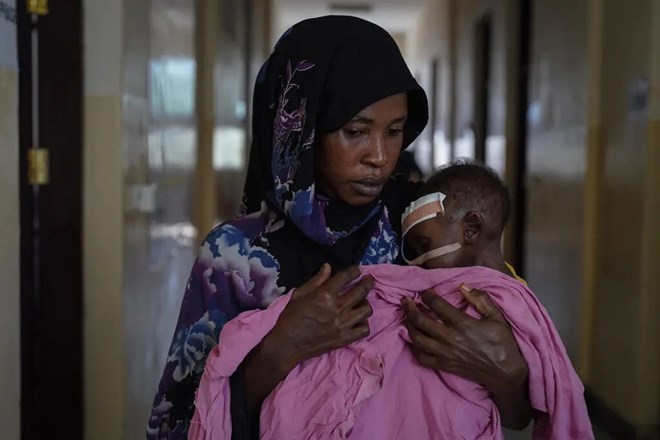
Mukta holding one of her seven children, 9-month-old Abdi, who is among the hundreds of thousands of Somali children suffering from severe acute malnutrition. Giles Clarke for The New York Times
MOGADISHU, Somalia — To outlive a child is to lose a piece of your heart. A famine looming over the Horn of Africa may soon leave hundreds of thousands more tiny graves pockmarking the arid landscape.
Somalia is a stark land of austere beauty, with farmers and goat-herders eking out a living from desert moonscapes. The country normally has two rainy seasons a year, but these have failed for two and a half years, shriveling crops and leaving carcasses of goats and cattle on the parched brown earth. Families are on the move, setting up colorful homemade tents and seeking work to earn cash to feed starving children.
advertisements
This may be, in part, on us: The worst drought in four decades is widely believed to be linked to climate change. The implication is that carbon emissions from wealthy countries are killing Somali children, tethering us to this crisis by a thread of moral responsibility.This is what drought looks like here: A 14-month-old girl, Sabirin Omar, suffers from kwashiorkor — an extreme form of protein deficiency. The girl’s skin is mottled and peeling, her hair is yellow and falling out, and her body is swollen from retained water.
“She’s not getting enough food,” explained her mom, Amina Moallim, 27, who has already lost three children. She explained that the family once owned 100 goats, but all have died and the family eats only when she or her husband find odd jobs paying at most $2 a day.
When they get the cash, the family shares a single meal a day, such as rice with a hint of tomato paste. There is no money for protein, so Sabirin is at risk of becoming the family’s fourth dead child.
Multiply Sabirin by hundreds of thousands, and you begin to see the picture. The United Nations cites estimates that as the crisis escalates toward famine, 1.8 million Somali children under 5 will be acutely malnourished by July.
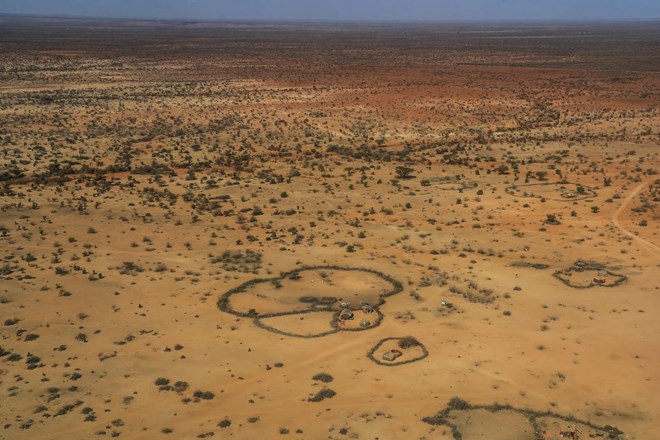
A landscape photograph from the sky of a desert in the Bay region in central Somalia. Greenery dots the land.Giles Clarke for The New York Times
To visit Somalia is to be dizzied by the world’s nutrition gaps.
Berco’s Popcorn in Chicago offers luxury “billion-dollar popcorn” with gold flakes at $2,500 for a large tin.
A pack of Plumpy’Nut, a high-protein, high-energy food for severely malnourished children like Sabirin, costs 38 cents. Two or three packs a day can revive a child.
What’s needed in Somalia isn’t just aid, however, but also peace. An extremist Islamic group, Al Shabab, is battling the government, and the combination of war and drought has driven some 3.8 million Somalis from their homes.
I flew into the Mogadishu airport on a United Nations plane. The area around the airport is well protected (when mortars aren’t falling), and international aid workers live within this fortified area, but traveling outside is complicated. One aid worker told me that he had been working in Somalia for three years and had driven out of the airport compound to visit Mogadishu only once.
When I traveled outside the protected area, it was in an armored vehicle escorted by plenty of armed men. If it’s this complicated for me to get around with just my notebook, imagine what it’s like to try to deliver assistance in remote parts of the country.
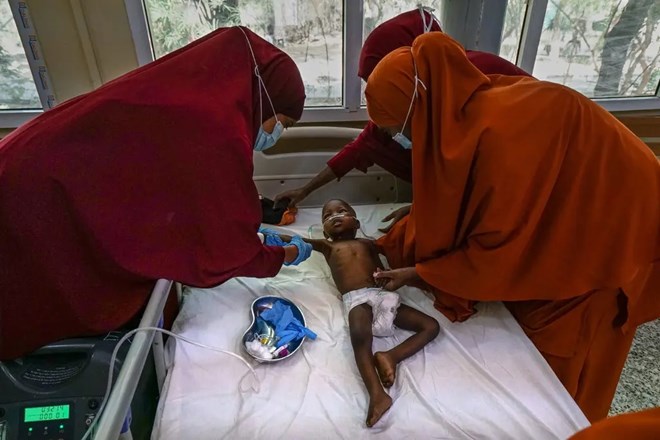
A medical team helps a young boy in the intensive care unit of Banadir Hospital in Mogadishu.Credit.Giles Clarke for The New York Times
Another war — the one in Ukraine — is also killing children here in Somalia. Some 90 percent of Somalia’s wheat imports used to come from Russia or Ukraine, and that war has raised prices of all food and fertilizer. Perhaps more important, it has diverted attention and assistance that would otherwise have eased the humanitarian crisis here.
UNICEF estimates that its cost to prevent severe acute malnutrition is $55 per child a year, or just 15 cents per day.
A large American dog easily consumes $2 worth of dog food each day.
I’m not trying to shame Americans who love their dogs and relish their luxuries (me included!), and in truth the United States has been generous toward Somalia, providing $1.3 billion in aid since October 2021 — two-thirds of the humanitarian assistance here. Europe and the Gulf countries can and should follow the American example and do more.
But let’s face it: These are responsibilities the rich world should accept when our pets are dieting and Somali children are starving.
Starvation doesn’t just kill children, of course; it also pulls them from school and forces girls into early marriages, sometimes with much older men.
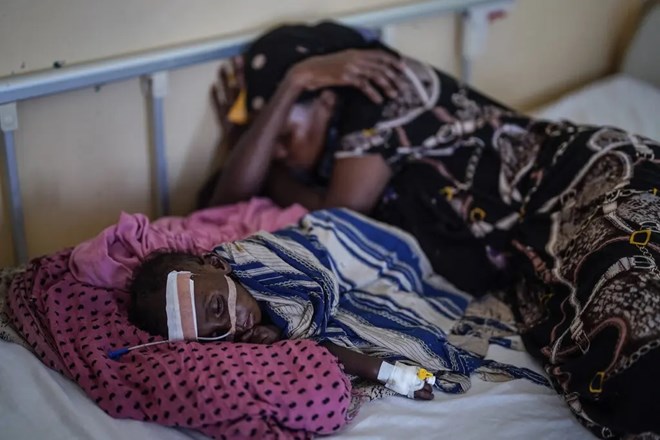
A photograph of a woman sleeping on a hospital bed next to a small malnourished child. The child has a bandage on his forehead and is swaddled in a blue and white blanket. Credit. Giles Clarke for The New York Times
Habiba Abdulahi, 40, has already lost four children and is caring for a desperately ill fifth child. Now she is discussing a way forward: marrying off her 13-year-old daughter, Luul.
“With all the problems now, if I can find a good husband for her, I will marry Luul,” she said.
Luul herself has not been consulted and is unaware that marriage may be on the horizon. The girl’s grandmother, Hawa Ibrahim, who has lost seven grandchildren, acknowledged that Luul is young to marry but sees a wedding as a route to family survival. Not only would the family then have one fewer mouth to feed, but it would also receive a bride price for Luul that could feed the others.
“If the man has good money, we’ll marry her,” she said.
That seemed harsh. But I wondered: If I had lost seven grandchildren and was watching an eighth fight for his life, would I see things differently?
A famine in 2011 in Somalia claimed 260,000 lives, and that followed a drought of three rainy seasons in which the rains failed to come. This time, five rainy seasons have failed, and some worry that the situation is more dire.
But even when there is no drought, Somalia loses children to malnutrition at a horrendous rate. In 2020, about 72,000 children died in Somalia, half from hunger-related causes, UNICEF says.
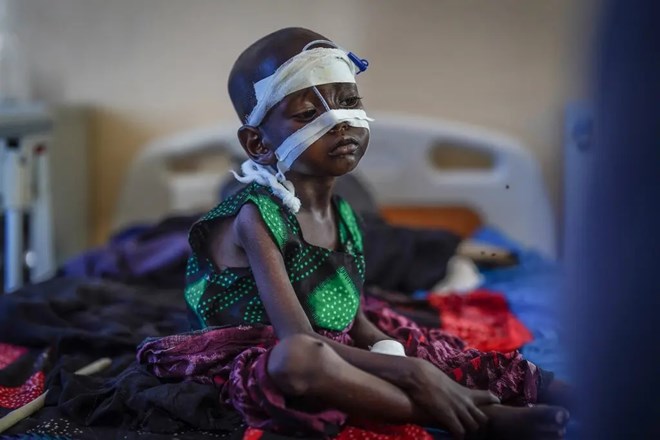
With support from Unicef and Concern Worldwide, Banadir Hospital is doing a heroic job keeping sick children alive.Credit.Giles Clarke for The New York Times
Let me just acknowledge, though, that all the numbers in this article may be wrong, for it’s impossible to gather accurate data in an impoverished country in the middle of a war. UNICEF statisticians acknowledge that actual child mortality in 2020 could have been lower than 35,000 or higher than 156,000.
Somali statistics are full of oddities. Supposedly 14 percent of women are obese, although I didn’t meet any of them, and childhood stunting from malnutrition purportedly is below average for Africa. I doubt that. But while Somalia’s numbers are uncertain, the hunger is not and the deaths are not. Neither is the rapid slide toward increased starvation.
Bling H20 sells “handcrafted alkaline water” in a bottle with Swarovski crystals for $2,700 a bottle.
Somalis in resettlement camps pay 4 cents to fill a 20-liter jerry can with water. This is twice the price it was a year ago, so water is becoming unaffordable for uses such as washing.
“We use water for cooking and drinking,” explained Marko Ali, a mom huddled over her baby boy in Banadir Hospital in Mogadishu. “We don’t spare water for bathing or hand-washing.”
Perhaps as a result, her son, Mohamed, has a severe case of cholera. Malnutrition often kills children indirectly by weakening the body, so the immediate cause of death can be cholera, measles, pneumonia or diarrhea.
“Hygiene gets worse in an economic crisis, when people can’t afford to use water,” explained Dr. Hafsa Mohamed, a pediatrician at Banadir Hospital, which with support from UNICEF and Concern Worldwide is doing a heroic job keeping sick children alive.
A majority of the children in the hospital have worms, she said, and she showed photos of one child vomiting worms and another with a diaper full of worms. The parasites leave such children anemic, and what food they get may go to the worms rather than to their own bodies.
An albendazole deworming pill, when purchased by UNICEF in bulk, costs 4 cents and can kill the worms.
The average American spends more than $1,300 per year on food that is wasted and thrown away.
We can’t fix every problem in the world, but I think we do owe some obligation to families losing children to today’s climate disasters — even if there is inevitably some uncertainty about how much of any particular crisis can be attributed to global warming. The climate is changing, and the United States has cumulatively emitted 12,000 times as much carbon as Somalia has, so let’s accept a measure of responsibility.

Displaced women wait for humanitarian assistance at a distribution site.Credit.Giles Clarke for The New York Times
What would discharging our responsibility look like?
It would mean an even greater international effort, now, to avert this looming famine in the Horn of Africa and to invest in resilience measures such as dams and drought-resistant seeds so that hunger does not follow each failed rainy season. One study found that each dollar invested in resilience reduces later losses and humanitarian spending by up to $3.
It’s true that some aid will seem misspent. We will give Plumpy’Nut to parents of severely malnourished children, and they will share it with their other hungry children. Or maybe the rains will fall, the war will subside, and the famine warnings will prove a false alarm. It’s fair to note that humanitarians have predicted 10 of the past five famines.
Yet the alternative risk is that we will be shamed by the worst famine of this century and that hundreds of thousands of children will perish unnecessarily.
“Somalia is the epicenter of the global hunger crisis, with a scale of death that potentially we haven’t seen in 50 years,” said Reena Ghelani, the United Nations famine coordinator. “This generation of children will not recover.”
As I interviewed starving Somalis, I found myself thinking an unbearable thought: A mistreated chicken or hog on an American factory farm enjoys better odds of survival than a child in Somalia.
About 5 percent of American chickens die before maturity, while 11 percent of Somali children already die before the age of 5 — and this will soar if famine arrives this spring.
“All lives have equal value,” we say, but a Somali child’s life is treated as if it were less valuable than that of a chick bound for the dinner table.
So can we afford to help Somalis? At a moral level, can we afford not to?